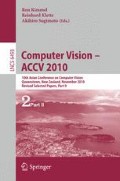Abstract
Estimation using homogeneous entities has to cope with obstacles such as singularities of covariance matrices and redundant parametrizations which do not allow an immediate definition of maximum likelihood estimation and lead to estimation problems with more parameters than necessary. The paper proposes a representation of the uncertainty of all types of geometric entities and estimation procedures for geometric entities and transformations which (1) only require the minimum number of parameters, (2) are free of singularities, (3) allow for a consistent update within an iterative procedure, (4) enable to exploit the simplicity of homogeneous coordinates to represent geometric constraints and (5) allow to handle geometric entities which are at infinity or at least very far, avoiding the usage of concepts like the inverse depth. Such representations are already available for transformations such as rotations, motions (Rosenhahn 2002), homographies (Begelfor 2005), or the projective correlation with fundamental matrix (Bartoli 2004) all being elements of some Lie group. The uncertainty is represented in the tangent space of the manifold, namely the corresponding Lie algebra. However, to our knowledge no such representations are developed for the basic geometric entities such as points, lines and planes, as in addition to use the tangent space of the manifolds we need transformation of the entities such that they stay on their specific manifold during the estimation process. We develop the concept, discuss its usefulness for bundle adjustment and demonstrate (a) its superiority compared to more simple methods for vanishing point estimation, (b) its rigour when estimating 3D lines from 3D points and (c) its applicability for determining 3D lines from observed image line segments in a multi view setup.
Access this chapter
Tax calculation will be finalised at checkout
Purchases are for personal use only
Preview
Unable to display preview. Download preview PDF.
References
Åstrom, K.: Using Combinations of Points, Lines and Conics to Estimate Structure and Motion. In: Proc. of Scandinavian Conference on Image Analysis (1998)
Bartoli, A., Sturm, P.: Nonlinear estimation of the fundamental matrix with minimal parameters. IEEE Transactions on Pattern Analysis and Machine Intelligence 26, 426–432 (2004)
Bartoli, A., Sturm, P.: Structure-from-motion using lines: Representation, triangulation and bundle adjustment. Computer Vision and Image Understanding 100 (2005)
Begelfor, E., Werman, M.: How to put probabilities on homographies. IEEE Trans. Pattern Anal. Mach. Intell. 27, 1666–1670 (2005)
Bohling, G.C., Davis, J.C., Olea, R.A., Harff, J.: Singularity and Nonnormality in the Classification of Compositional Data. Int. Assoc. for Math. Geology 30(1), 5–20 (1998)
Bregler, C., Malik, J.: Tracking people with twists and exponential maps. In: Proc. Computer Vision and Pattern Recognition, pp. 8–15 (1998)
Collins, R.: Model Acquisition Using Stochastic Projective Geometry. PhD thesis, Department of Computer Science, University of Massachusetts (1993); Also published as UMass Computer Science Technical Report TR95-70
Criminisi, A.: Accurate Visual Metrology from Single and Multiple Uncalibrated Images. In: Distinguished Dissertations. Springer, Heidelberg (2001)
Frstner, W.: Optimal Vanishing Point Detection and Rotation Estimation of Single Images of a Legolandscene. In: Int. Archives for Photogrammetry and Remote Sensing, vol. XXXVIII/3A, Paris (2010)
Gebken, C.: Comformal Geometric Algebra in Stochastic Optimization. PhD Thesis, University of Kiel, Institute of Computer Science (2009)
Heuel, S.: Uncertain Projective Geometry: Statistical Reasoning For Polyhedral Object Reconstruction. LNCS. Springer, New York (2004)
Jain, A., Kurz, C., Thormälen, T., Seidel, H.P.: Exploiting Global Connectivity Constraints for Reconstruction of 3D Line Segments from Images. In: Conference on Computer Vision and Pattern Recognition (2010)
Kanatani, K.: Statistical Optimization for Geometric Computation: Theory and Practice. Elsevier Science, Amsterdam (1996)
Koch, K.R.: Parameter Estimation and Hypothesis Testing in Linear Models. Springer, Heidelberg (1999)
Liebowitz, D.: Camera Calibration and Reconstruction of Geometry from Images. PhD thesis, University of Oxford, Dept. Engineering Science (2001)
McGlone, C.J., Mikhail, E.M., Bethel, J.S.: Manual of Photogrammetry. Am. Soc. of Photogrammetry and Remote Sensing (2004)
Meidow, J., Beder, C., Förstner, W.: Reasoning with uncertain points, straight lines, and straight line segments in 2D. International Journal of Photogrammetry and Remote Sensing 64, 125–139 (2009)
Pottmann, H., Wallner, J.: Computational Line Geometry. Springer, Heidelberg (2010)
Rosenhahn, B., Granert, O., Sommer, G.: Monocular pose estimation of kinematic chains. In: Dorst, L., Doran, C., Lasenby, J. (eds.) Applications of Geometric Algebra in Computer Science and Engineering, Proc. AGACSE 2001, Cambridge, UK, pp. 373–375. Birkhäuser, Boston (2002)
Sturm, P., Gargallo, P.: Conic fitting using the geometric distance. In: Proceedings of the Asian Conference on Computer Vision, Tokyo, Japan, vol. 2, pp. 784–795. Springer, Heidelberg (2007)
Author information
Authors and Affiliations
Editor information
Editors and Affiliations
Rights and permissions
Copyright information
© 2011 Springer-Verlag Berlin Heidelberg
About this paper
Cite this paper
Förstner, W. (2011). Minimal Representations for Uncertainty and Estimation in Projective Spaces. In: Kimmel, R., Klette, R., Sugimoto, A. (eds) Computer Vision – ACCV 2010. ACCV 2010. Lecture Notes in Computer Science, vol 6493. Springer, Berlin, Heidelberg. https://doi.org/10.1007/978-3-642-19309-5_48
Download citation
DOI: https://doi.org/10.1007/978-3-642-19309-5_48
Publisher Name: Springer, Berlin, Heidelberg
Print ISBN: 978-3-642-19308-8
Online ISBN: 978-3-642-19309-5
eBook Packages: Computer ScienceComputer Science (R0)

